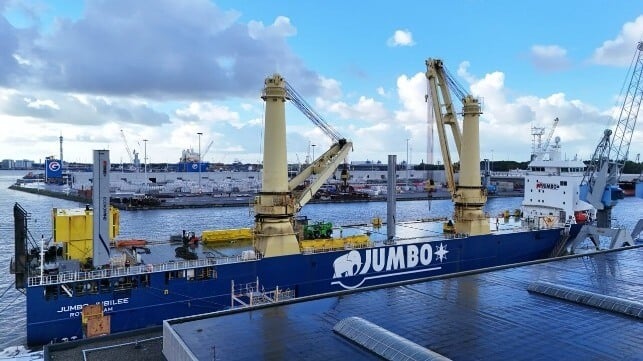|
Jumbo, one of the leaders in heavy lift transport, has begun testing wind-assisted propulsion aboard one of its vessels. It is part of a program adding different elements to its vessels to measure the results in improving performance and providing energy savings the company reports.
The vessel is the Jumbo Jubilee, a heavy lift carrier built for the company in 2009. It is 13,000 dwt and measures approximately 476 feet (145 meters). The vessel is powered by two MAK diesel engines that provide a total of 9000 kW and a speed of up to approximately 16 knots.
The retrofit was carried out with two mechanical sails to test the performance on the vessels. Jumbo selected two Econowind ventofoils. They are mechanical wings that create added thrust for the vessel. Econowind has previously installed its technology on a range of vessels including shortsea cargo vessels operating in the North Sea and Northern Europe with positive results.
The companies highlighted the wings have a small footprint and are low weight which made them well-suited for the heavy lift vessels, where space is required for project cargo. Jumbo Jubilee has 3,000 square meters of deck space which is critical for cargo.
“While not fully optimized for our vessel type, these sails will help us to gather valuable insights on real-world fuel savings and explore further optimizations that will allow Jumbo to reduce its environmental footprint even more,” explains Andres Cassanova, Technical Manager for Jumbo.

The company highlights that the sails were flexibly mounted on a customized frame engineered in-house by Jumbo structural engineer Estelle Bongers. With this, the sails can be moved, or even transferred to another vessel should additional space be required for cargo.
The installation of the ventofoils follows the application of an anti-fouling coating on the ship’s propeller to maintain efficiency, as well as the introduction of an AI-powered anti-fouling hull coating monitoring system. The system captures a wide range of data including vessel speed, geographical position, as well as seawater temperature, and other environmental conditions and parameters. Jumbo says the information allows the system to make predictions and provide notifications when there is a risk of accelerated fouling.
Jumbo says it can perform an inspection and undertake maintenance in advance of a decrease in fuel efficiency. It also means the system can be maintained using less aggressive methods, ensuring its preservation for longer durations between dockings. A further measure is the installation of an eco-control system on the vessel.
“This can be viewed as a type of intelligent cruise control,” explains Cassanova. “It allows us to set a fuel consumption or maximum speed limit. With this, the eco-control system takes over and, based on RPM and propeller pitch, is continually adjusting to ensure optimally efficient performance, minimal fuel consumption, and emissions.”
The company expects to achieve further fuel savings. It will be measuring the results as part of its broader effort to install technologies to boost fuel efficiency and cut carbon emissions.
https://maritime-executive.com/article/jumbo-adds-wind-assisted-propulsion-using-ventofoils-on-heavy-lift-vessel
|